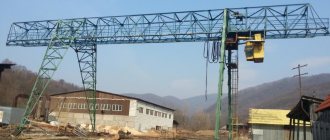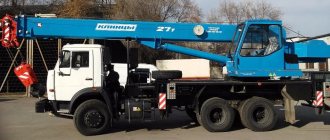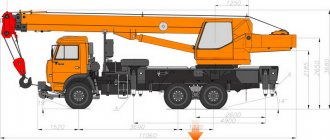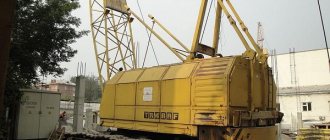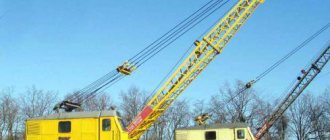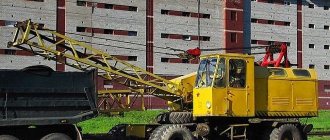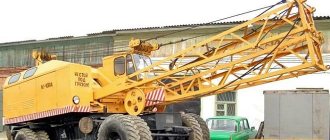Review of the design and technical characteristics of the KK-12.5 gantry crane
The KK-12.5 crane installation is designed to perform large-scale work of industrial, construction and municipal importance.
Special equipment is also used for unloading and loading goods in large warehouses, covered hangars, ports and docks. The technical characteristics of the KK-12.5 gantry crane provide the special equipment with resistance to high mechanical loads, durability and high repairability. The KK lattice type provides the crane installation with minimal windage. It is maintained along the entire length of the bridge even under conditions of maximum weight loads.
- metal bridge frame;
- fixed load trolley;
- main support posts;
- platform;
- load lifting mechanism;
- cargo trolley movement system;
- crane movement mechanism.
Today, a wide range of KK-12.5 cranes are produced on the Russian Federation special equipment market; each type of equipment has different dimensional parameters, a detailed description of which is presented in the table.
Features of operation
The crane is delivered to the construction/loading site in disassembled form. Already at the work site, installation of both the rail system and the model itself is carried out. Smooth operation is ensured by the design features of the crane and the correct placement of equipment.
The lattice type KK-12.5 makes it possible to use a minimum amount of electricity when moving around the site. The crane moves freely throughout the entire working area if the rail system is properly developed. It is along them that the crane moves. It is provided by high-speed mechanisms, due to which all work is carried out at the required production pace.
The cabin of the KK-12.5 crane provides high-quality visibility to the crane operator.
Installation of closed-type electrical equipment allows you to increase the protection of both the equipment itself and the crane operator from accidental electric shock.
This also simplifies operation. To control and operate the KK-12.5 crane, no additional training is required for crane personnel and the crane operator himself.
As a rule, control cabinets are forcedly heated (convection type), which ensures operation at low temperatures. But due to the fact that the crane is made in the U1 climate design, it is designed to operate in a temperate climate. Therefore, its use in conditions of extremely low temperature zones and the Far North is unacceptable.
Photo of gantry crane KK-12.5
The lifting mechanism works correctly at temperatures not lower than minus 40 and not higher than plus forty. It is quite earthquake resistant. Can withstand fluctuations of up to 8 points (according to SNiP 11-7-81). But it is better to stop work already at 6. Regarding the permissible speed of wind gusts, this is 14 m/s. A non-working state occurs when gusts reach 27 m/s.
Useful information
A gantry crane is very convenient to use, as it is capable of moving huge loads without taking up much space on the ground. The equipment is delivered to its destination in disassembled form, and is assembled directly at the place of operation.
The gantry crane moves on rails, so a flat surface is required for its installation. To do this, before assembling and installing the lifting mechanism, a foundation is made at the installation site on which the rails are installed.
Main technical characteristics of the KK-20-32 gantry crane:
load capacity - 20 tons;
crane span - 32 meters;
maximum lifting height - 8.65 meters;
working console reach - 7 meters;
lifting speed - 4.4 meters per minute;
lifting mechanism travel speed - 24 meters per minute;
the speed of movement of the crane on rails is 25 meters per minute;
load stability coefficient - 2.2;
the total weight of the entire structure is 50 tons;
operating voltage - 380 Volts;
operating frequency - 50 Hz.
Control is carried out from the cabin. The lifting mechanism has a very smooth motion and high precision movements. This allows you to move even the most fragile types of cargo.
The crane was originally intended for open-air operation, so a high margin of safety was built into its design. Equipment that was produced more than 30 years ago is still successfully used. Therefore, if service is carried out on time, the crane will serve for decades.
You can purchase gantry cranes either from manufacturers or on the secondary market. The second option allows you to save an impressive amount of money. In general, buying equipment that has already been used is quite popular in Russia. This is due to the loyal price level. For example, prices for a used Ural timber truck with a manipulator on average across the country are 2-3 times lower than the cost of new special equipment.
Important How to make a homemade all-terrain vehicle from a walk-behind tractor: features of operation
Trust the loading and movement of heavy objects to reliable gantry cranes KK-20-32!
Equipment
Depending on customer requirements, the cabin can be of two types:
- mobile;
- stationary.
Crane KK-12.5 with a stationary cabin
Cranes designed for loading/unloading bulk and timber materials require the installation of grabs.
Grabs can be 3 cubic meters in volume for bulk materials and 4.8 cubic meters for timber. It is possible to install monorail or single-rail cargo trolleys. The mechanism of their movement is a rope system and is controlled from the crane itself.
Electric drive control systems:
- movement of both the crane itself and the trolley - contactor and thyristor, frequency and throttle types;
- rise - contactor, frequency and thyristor.
Standard models are equipped with:
- load limiter;
- temperature relay;
- wind pressure indicator;
- anti-theft grip.
The maximum lifting height is 11 meters.
A flexible cable supplies current to the tap and is wound onto a cable drum.
Light crane KKT-5
KKT-5 - Gantry Crane with Telpher (electric hoist), lifting capacity = 5t. Used for work with light or medium loads (2-10t), in construction, industrial hangars, shipbuilding.
OPI, PBI and VBI (general industrial, fireproof, explosion-proof use) for any lifting operations with load weight ≤ 5t.
Gantry crane 5 tons - 2-cantilever, lifting mechanism - electric. tal, (3 phases, alternating current, voltage = 380V, current frequency = 50Hz).
Gantry crane KKT-5 - technical characteristics
- lifting height = 7.1-11.2m;
- wind load - up to V degree (inclusive);
- span = 6/9/12/12.5/16/18/20/22/25/32m;
- current supply - cable drum, cable carabiner, trolleys (on special order);
- weight = 16-50t;
- lightweight KKT-5 works both in open areas and indoors at production bases, factories and warehouses;
- control using a remote control.
Self-erecting gantry crane KKS-10
KKS-10 - two-console KK - modernization of the previously produced KKU-7.5 and KKU-10.
A bridge-type lifting unit on supports moves along the rails of the crane runway on wheels with flanges.
KKS-10 can be equipped with various working equipment:
- hook - standard equipment;
- grab - transportation of loading bulk cargo within the work site;
- electromagnet - for working with metal.
The design of the KKS-10 crane has its own characteristics and technical characteristics:
- The supports and the bridge have a lattice structure, which lightens the weight while maintaining the strength and operating parameters of the unit (load capacity, speed, etc.).
- The cargo trolley is a monorail, suspended type. Above the monorail there is a grated flooring for passage along the entire length of the bridge.
- To avoid loosening of the moving mechanisms of the cargo trolley and the cabin, special rollers are installed, fixed on the main frame with support on the lower chord of the bridge.
- Control method: from the floor/cabin.
- Repair platforms are mounted on the crane console.
- The safety system consists of: extreme position limiters, tilt sensors, buffer devices, wind pressure alarm, and sound alarm.
Important Technical characteristics and operating features of the chain saw Partner 351
KKS-10 - technical characteristics:
- load capacity 2-10t;
- lifting height = 7.1-11.2m;
- wind load - up to V degree (inclusive);
- span length = 14-32 meters;
- current supply - cable drum, cable carabiner, trolleys (on special order);
- weight = 42t.
Recommended changes in crane electrical circuits
During planned repairs, the crane must be taken out for repairs by a person responsible for maintaining lifting machines in good condition, in accordance with the schedule of planned repairs with the issuance of a work order for work in electrical installations. Ultimate protection is provided by switch SQ.
Single buttons perform normally open and open with a mechanical return to their original position; The buttons have rear wire connections. The engine then runs idle for min.
Electrical diagrams of crane lifting mechanisms In Fig. Silver contacts are cleaned with a velvet file or chamois leather.
Before installation, the brush must be processed along the radius of the ring.
Flexible trolleys are made of copper wires stretched between supports, working with special current collectors. Low heating temperature of the resistances indicates an excessive number of elements. The high speed electric motor is turned on during high speed operation.
It is not recommended to use sandpaper or glass paper for this purpose. Kone gantry crane. Loading timber.
Gantry crane KKS-12.5
Introduction
Rail transport in our country is the leading mode of transport.
It provides the most massive transportation, is characterized by regular traffic at all times of the year, high speed and relatively low cost of cargo transportation. Railway transport accounts for more than seventy percent of the country's domestic freight turnover. Significant development of railway transport and further intensification of its work are envisaged, which will lead to an increase in the throughput and carrying capacity of railways, an increase in freight and passenger turnover, as well as an increase in the weight of freight trains and speeds on railways.
The continuous increase in the intensity of railway transport is ensured by a systematic increase in labor productivity and the systematic development of all sectors of transport based on the introduction of new models of electric and diesel locomotives, heavy-duty rolling stock, automation and mechanization equipment, as well as the widespread use of modern superstructure structures.
Strengthening the track as a result of laying in ever increasing quantities heavy type rails, continuous welded track, reinforced concrete sleepers, new types of fastening of rails of the ARS system and crushed stone ballast, improvement of the roadbed and maintenance of the track in good condition are unthinkable without the widespread use of modern high-performance machines and mechanisms various types and purposes.
In recent years, comprehensive mechanization of the most difficult and labor-intensive operations performed during major and medium track repairs has been largely completed.
Gantry crane KKS12.5
A gantry crane is characterized by the fact that the load-bearing structural elements rest on the crane runway using two support posts.
Gantry crane is one of the main loading and unloading machines that perform loading and unloading operations with containers, bulk, heavy cargo, timber, etc. At railway freight stations, double-cantilever gantry cranes are most widely used, allowing the most efficient use of warehouse space, since the road access and the railway track are located under the consoles, and the cargo occupies the entire span of the crane. Like all overhead cranes, a gantry crane performs operations such as lifting and lowering loads, moving them along the bridge and along the warehouse.
For loading and unloading long cargo at railway stations and access roads of industrial enterprises, KKS12.5 gantry cranes are used (Fig. 1). The crane bridge 10 is made in the form of a large-section lattice truss made of small-section rolled products, which significantly reduces the weight of the crane, but such a bridge is less technologically advanced to manufacture. It consists of three sections 3, 5 and 6 in the span and two consoles 1 and 9. All sections have flanges for bolting them together
At the request of the customer, one of the sections in the span can be removed, reducing the span from 32 to 20 m. Supports 2 and 7 are attached to the bridge with side flanges, which made it possible to increase the base of the crane and provide a wide clearance between the supports, allowing you to move loads up to length between the supports without turning 8 m at a height of 8 m.
Cargo trolley KKS12.5
The cargo trolley of the KKS12.5 crane (Fig. 2) moves along a monorail laid along the lower chord of the bridge truss on support rollers 8 mounted in articulated axles 7. The cargo trolley of the KKS10 crane moves on four pairs of rollers, and KKS12.5 on five pairs . The frame 1 of the trolley has a welded structure made of channels with 4 posts at the corners. Parallel to the monorail, guides are attached to the truss, along which balancing rollers 5 roll, preventing distortion when the trolley moves. A lifting mechanism is mounted on the frame of the trolley, consisting of an electric motor 11, gear couplings 13, an intermediate shaft 12, a gearbox 6, a drum 9, a brake 3 with an electric hydraulic pusher and a limit switch 10 for lifting the hook. Fixed blocks of 2 triple double pulley hoists are mounted on the frame. The trolley is moved using a stationary traction winch (Fig. 3) installed on the crane bridge. An electric motor 8 is mounted on the frame 4. The rotation from which, through a coupling with a toothed sleeve 1 and a cage 2 with a brake pulley 3, is transmitted to the drive shaft of a gearbox 6, which has a standard connection to a drum 5. The winch is braked by a brake 4, closed by a casing 7. Along the edges of the drum Two traction ropes are attached with one-sided threading (see Fig. 3, c). A long rope runs inside the truss along supporting blocks, goes around guide blocks and is attached to the load trolley. A short rope goes around the guide blocks and is attached to the cart on the other side. As the drum rotates, one end of the rope is wound up and the other is wound into the free grooves, moving the cart in one direction or another.
Description and main features
As a rule, a gear ring or hub
, which serves to interface with the gearbox.
In addition, flanges are welded to the pipe, onto which hubs are installed for pressing the shaft. a groove
on the outer surface of the device , which allows the cable to be laid evenly in one layer.
It can be left or right (this depends on the required installation direction). This reduces the tension
between the rope and the drum itself.
Such products belong to the category of general industrial
(with a diameter of 160-1000mm and a length of 320-1800mm), which are produced in accordance with the requirements established by
GOST 30077-93
. Since they are in conditions of constant friction and are subject to increased loads, over time they need to be replaced with new parts. This can occur when the rolling surface is worn down to more than 20% of its original size, as well as when through cracks and visible damage are detected.
The cargo drum assembly KS.10.12.000 is part of the load lifting mechanism of gantry cranes KKS-10 and KK-12.5, which also includes a winch, trolley and other auxiliary equipment. With the help of these devices, the machine can lift and move loads to the required height. Rope drum assemblies are mounted on ball bearings. Their total weight depends on the standard sizes of individual models, which varies from 146 kg to 1440 kg.
Important Characteristics and design of the MTZ-80 universal tractor
It is important to remember that the safe operation of all equipment depends on the serviceability of the drum. When using a failed element, an emergency situation may arise, which will not only lead to the breakdown of the entire expensive special vehicle as a whole, requiring more expensive repairs, but also risks causing human casualties
For this reason, it is strongly recommended to carry out regular technical inspections and promptly resolve problems. If visible damage is found on the outer surface, the drum should be replaced with a new one, resuming the correct operation of the KKS-10 and KK-12.5 gantry cranes.
- D
– diameter, - D1
– ring gear diameter, - d
– shaft diameter, - R
is the radius of the groove, - t
– groove cutting pitch, - h
– groove profile height, - dk
– rope diameter.
